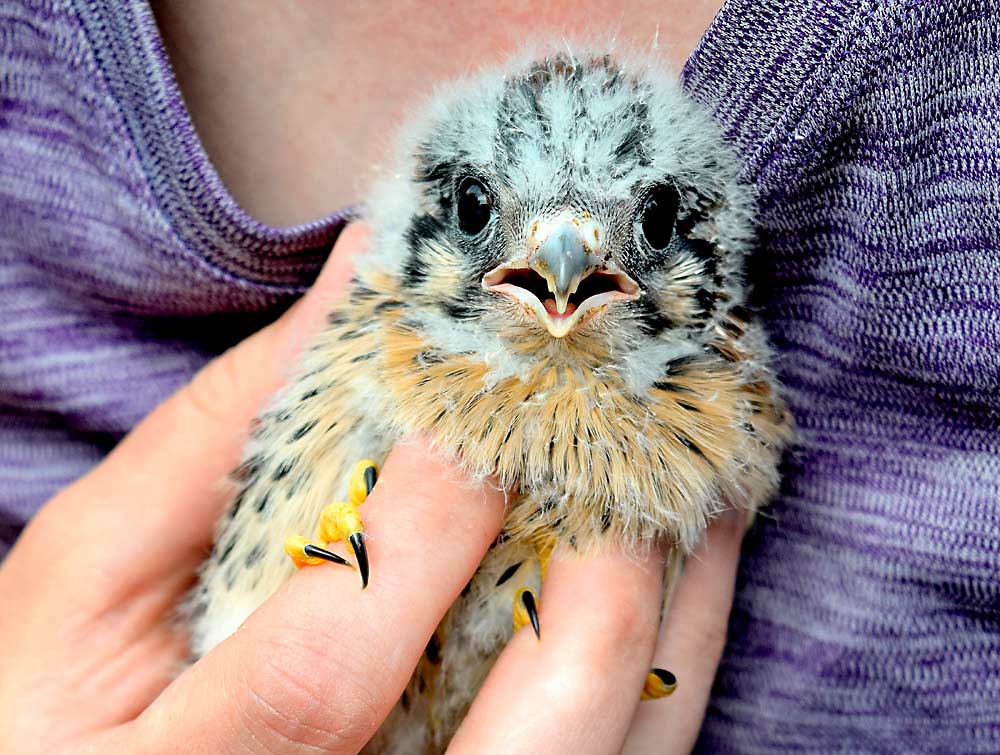Studying kestrels' superpower to shoo pest birds
Can the presence of kestrels, chasing away pest birds, impact fruit quality and food safety in a sweet cherry orchard?
Already, the experience of researchers and growers has shown that attracting kestrels to Northwest Michigan orchards can improve fruit quality by reducing the population of pest birds. Now, the question of whether fewer pest birds improves food safety is set to be answered.
.JPG)
Michigan State University postdoctoral research associate and EEB member Olivia Smith studied the food safety question over the past two seasons and will discuss her results during a cherry session at the 2022 Great Lakes Fruit, Vegetable and Farm Market EXPO in Grand Rapids, Michigan, in December.
Smith, a postdoctoral researcher in the Center for Global Change and Earth Observations
mentored y Catherine Lindell and Jen Owen, was still finalizing results when she spoke
with Good Fruit Grower, but the preliminary data shows that fewer cherry branches had bird feces on them
when kestrels were nesting nearby, lowering the risk of foodborne pathogens on cherries.
The kestrel, a small North American falcon, deters pest birds both by eating them and scaring them off. The generalist predator prefers somewhat open landscapes with trees and other cavities where it can

nest. Kestrels are numerous in Northwest Michigan, home to most of the state's cherry orchards, and are easy to attract with nest boxes, Smith said.
The kestrel's nesting period coincides with the region's cherry harvest in July, said Heather Leach, orchard manager for Cherry Bay Orchards, a large grower in the region.
Fruit-eating pest birds also are common in Northwest Michigan and can do a lot of damage to cherries. Based on MSU research, many growers have installed kestrel nest boxes in their cherry orchards, said Nikki Rothwell, coordinator of MSU's Northwest Michigan Horticulture Research Center.
Smith's food safety project expanded on the work of Megan Shave and other researchers in professor Catherine Lindell's MSU biology lab. In 2018, the Lindell team published a study showing that fruit-eating bird counts were significantly lower in Northwest Michigan sweet cherry orchards with active kestrel nest boxes. Smith wanted to learn if fewer pest birds would translate to fewer feces on trees, thereby improving food safety, she said.
Bird feces is a major food safety concern at California and Washington farms, said Smith, who did her doctoral research in biology at Washington State University. Birds near feedlots typically carry higher food safety risks, but Northwest Michigan is not a livestock-heavy region, she said.
Smith conducted bird surveys in 16 sweet cherry orchards in 2021 and 2022. Roughly half the sites had active kestrel nest boxes. She focused on sweet cherries, because prior work has shown that pest birds are more commonly found in sweet cherry blocks than tart cherry blocks, possibly because of their higher sugar content, she said.
Smith's team observed 27 bird species in cherry orchards. The most common were the American robin, common grackle and black-capped chickadee. Using mist netting to trap birds, they collected 122 fresh fecal samples from 20 species. They detected foodborne bacteria in five of those samples. However, they detected foodborne bacteria in less than 1 percent of the fecal samples they collected from trees, and all tree detections were from sites that did not contain kestrel boxes, Smith said.
Attracting kestrels to orchards adds the risk of kestrel feces, of course, but orchards with kestrels had fewer bird feces overall, Smith said.
To combat pest birds, Cherry Bay Orchards has tried bird cannons and avian control repellents in the past, but the results of those methods did not justify their expense, Leach said.
Cherry Bay partnered with MSU on the kestrel project a few years ago. As soon as they set up nest boxes in their orchards, kestrels arrived, pest bird populations went down and cherry quality went up, Leach said.
Most of Cherry Bay's sweet cherries are sold for processing, but the need for effective bird control became more acute when the farm recently planted a high-density block of fresh-market sweet cherries. Pecking damage is a greater concern in fresh cherries, where appearance is paramount, she said.
"Quality matters a lot more," Leach said. "You don't want marked-up cherries in the grocery store."
The nest boxes worked so well that Cherry Bay set up more outside the scope of the research project. The company now has 30 nest boxes spread throughout its cherry orchards. The boxes are cheap and relatively simple to build, though they have to be cleaned out at the end of each year, she said.
"It's such a simple, straightforward management tool," Leach said. "It's pretty much the only tactic we use now."
MSU professor Lindell said growers can buy or construct wooden nest boxes themselves. The boxes her researchers used were placed on 15- or 18-foot poles. Some growers place them on utility poles, she said.
Nest boxes are equally effective on the margins or in the interior of an orchard. Lindell recommended growers place them where they won't interfere with orchard management activities and also keep them away from woodlots so they won't attract starlings.
Read the full story in Good Fruit Grower magazine.



